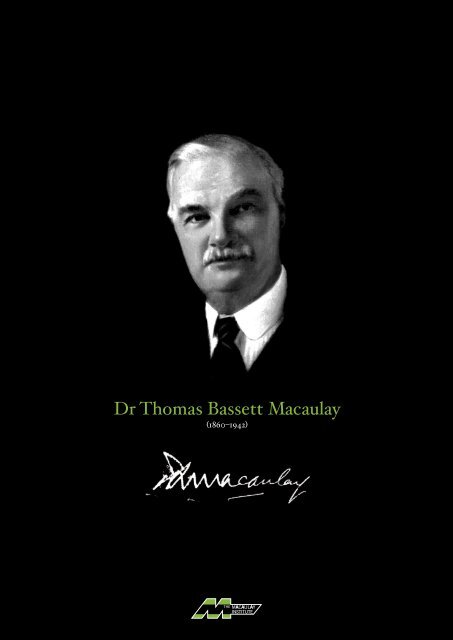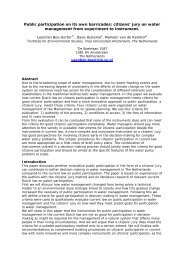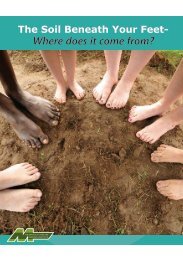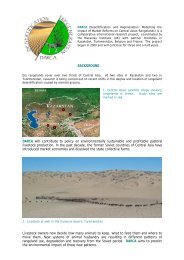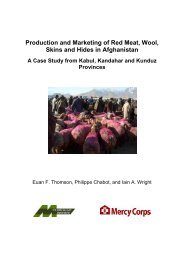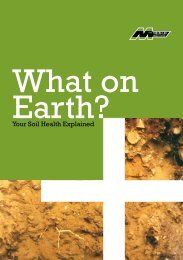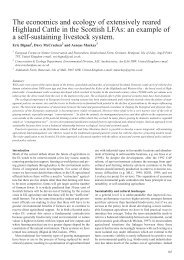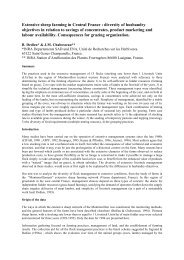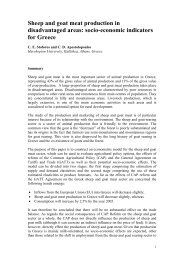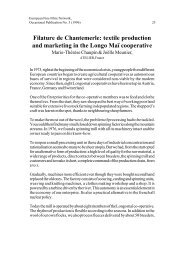Dr Thomas Bassett Macaulay - The Macaulay Land Use Research ...
Dr Thomas Bassett Macaulay - The Macaulay Land Use Research ...
Dr Thomas Bassett Macaulay - The Macaulay Land Use Research ...
Create successful ePaper yourself
Turn your PDF publications into a flip-book with our unique Google optimized e-Paper software.
<strong>Dr</strong> <strong>Thomas</strong> <strong>Bassett</strong> <strong>Macaulay</strong><br />
(1860–1942)
<strong>Dr</strong><br />
<strong>Thomas</strong><br />
<strong>Bassett</strong><br />
<strong>Macaulay</strong><br />
(1860–1942)<br />
T.B. <strong>Macaulay</strong>,<br />
one of Canada’s<br />
Scottish sons, is<br />
remembered for<br />
many things – not<br />
least of which is the<br />
foundation of the<br />
<strong>Macaulay</strong> Institute<br />
in 1930.<br />
Aside from his<br />
induction into the<br />
Insurance Hall of Fame<br />
(in recognition of his<br />
landmark presidency of<br />
the Sun Life Assurance<br />
Company of Canada),<br />
or that almost all<br />
Holstein cattle<br />
carry blood lines from<br />
his original herd,<br />
he was also a great<br />
humanitarian, donating<br />
considerable sums of<br />
money to many worthy<br />
causes both in Canada<br />
and his ancestral<br />
Scotland.
Robertson <strong>Macaulay</strong> (1853 – 1915)<br />
Scottish Roots of the<br />
<strong>Macaulay</strong> Family<br />
<strong>The</strong> <strong>Macaulay</strong> family originally hailed from Uig, on the Isle of Lewis. However<br />
T.B. <strong>Macaulay</strong>’s fisherman grandfather Captain Kenneth <strong>Macaulay</strong> had moved to<br />
Aberdeenshire for work, which meant Robertson <strong>Macaulay</strong> (father to T.B.) was<br />
actually born in Fraserburgh.<br />
As a young man he moved to Stornoway to<br />
live with his aunt. It was there that Robertson<br />
began his business apprenticeship in the<br />
office of Donald Munro, a respected solicitor,<br />
that stood him in good stead for the world of<br />
business and finance that lay ahead.<br />
He completed his business training in<br />
Aberdeen, and in 1854, on his 21st birthday and,<br />
fired with ambition, he left Scotland’s shores for<br />
Canada.<br />
Robertson <strong>Macaulay</strong> joined Sun Life as<br />
Secretary in 1874, and by 1889 he had become<br />
president. His character and strength is said to<br />
have left a lasting impression on the company.<br />
50 Shore Street,<br />
Fraserburgh,<br />
birthplace of<br />
Robertson <strong>Macaulay</strong><br />
T.B. <strong>Macaulay</strong> and<br />
Margaret Palin<br />
at Calanais,<br />
West Lewis,<br />
1929<br />
<strong>The</strong> seventeen year old <strong>Thomas</strong> <strong>Bassett</strong><br />
<strong>Macaulay</strong> followed in his father’s footsteps<br />
and in 1877 he joined the Sun Life Assurance<br />
Company of Canada. Over the next 47 years<br />
he had numerous roles including Actuary,<br />
Secretary, Managing Director, President and<br />
finally Chairman.<br />
Working Life<br />
After three years of intense private study, T.B.<br />
<strong>Macaulay</strong> was appointed the Company’s Actuary.<br />
In 1881 he was made an Honorary Associate of the<br />
Institute of Actuaries of Great Britain, without<br />
examination. When Canadian students were finally<br />
able to take the institution’s examinations he passed<br />
them all - in just three years. This accomplishment<br />
was achieved whilst executing his onerous duties in<br />
the relatively young company.<br />
Under his leadership and direction, Sun Life began issuing<br />
unconditional policies in the 1880s, the first company in the<br />
world to remove policy restrictions on travel, occupation,<br />
residence and suicide. Whilst initially drawing much criticism<br />
from larger and more established companies, the issuing of such<br />
policies rapidly became a worldwide practice.<br />
During the company’s formative years, <strong>Macaulay</strong> realised the<br />
limitations of the small Canadian market and set out on an<br />
international expansion plan for Sun Life. Starting in the West<br />
Indies in the 1880s and continuing through Asia, Central and<br />
South America in the 1890s, the company expanded its global<br />
reach to over 55 countries by the mid-1920s. Under <strong>Macaulay</strong>’s<br />
direction, new premium rates and products were developed and<br />
used in each of its international operations.<br />
Robertson <strong>Macaulay</strong><br />
‘Unconditional Policy’ advert, 1885<br />
T.B. <strong>Macaulay</strong><br />
Robertson <strong>Macaulay</strong> laying the<br />
cornerstone of the second<br />
Sun Life Head Office, 1914
Sketch of T.B. <strong>Macaulay</strong> from<br />
‘<strong>The</strong> President’s Book’<br />
(1928)<br />
<strong>The</strong> first Sun Life Head Office in<br />
Montreal<br />
Working Life<br />
Investment policies under T.B.<br />
<strong>Macaulay</strong> also took on greater<br />
significance. <strong>The</strong> company looked<br />
to common stock investments<br />
to increase its surplus and it was<br />
T.B. <strong>Macaulay</strong> who was one of<br />
the first to realise the potential<br />
of the new electricity and public<br />
utility developments and the<br />
related investment opportunities<br />
they created. Sun Life achieved<br />
great prosperity under <strong>Macaulay</strong>’s<br />
investment policies and through his<br />
drive, leadership and commitment<br />
the company became the largest<br />
assurance company in Canada and one<br />
of the world’s leading life assurance<br />
institutions.<br />
T.B. <strong>Macaulay</strong>’s life and career were<br />
characterised by great activity and relentless<br />
devotion, and although in business he will<br />
forever be primarily associated with Sun<br />
Life, he undertook numerous other roles and<br />
responsibilities in business and finance.<br />
He earned an extraordinary international<br />
reputation. He was a Fellow of the Institute<br />
of the Actuaries of Great Britain, a charter<br />
member of the Actuarial Society of America,<br />
he represented the actuaries of Canada and<br />
the US at the International Congresses<br />
at Paris and Berlin in 1900 and 1906<br />
respectively.<br />
He was a Fellow of the Royal Statistical<br />
Society, President of the Canadian Life<br />
Assurance Officers’ Association and<br />
represented the Leeward Islands at the<br />
Canadian West Indian Trade Conference<br />
in Ottawa. He was also the President of<br />
the Canadian West Indian League and was<br />
awarded honorary presidency of the Naval<br />
League of Canada. He became Chairman of<br />
the National Committee on Food Resources<br />
in 1917 and became the governor of both the<br />
Montreal General Hospital and the Fraser<br />
Institute Public Library. descent, <strong>Dr</strong> <strong>Macaulay</strong> wished to share his Aberdeen University conferred <strong>Macaulay</strong><br />
T.B. <strong>Macaulay</strong>’s 1929 visit to his<br />
experimental farm on Lewis<br />
Extract from<br />
minutes of<br />
Sun Life Board<br />
Meeting<br />
October 1927,<br />
congratulating<br />
T.B. <strong>Macaulay</strong><br />
on fifty years<br />
service<br />
Philanthropy<br />
Apart from his commitments to business and finance, <strong>Dr</strong> <strong>Macaulay</strong> was also a respected humanitarian,<br />
who busied himself with numerous goodwill causes. With several friends from his Bible discussion group<br />
he formed the Welcome Hall Mission in 1892.<br />
<strong>The</strong> aim of the mission was to assist the<br />
young men whom he encountered as a<br />
parishioner at the Calvary Congregational<br />
Church and it fed those people, and<br />
offered a bed and spiritual guidance. In<br />
1992 the Mission celebrated its 100th year<br />
of continuous operation, and it still exists<br />
today. <strong>Macaulay</strong> also found time to organise<br />
summer camps for underprivileged boys<br />
from Montreal’s slums.<br />
Despite adopting numerous roles in the<br />
country of his birth, and immersing himself<br />
fully in the Canadian way of life, T.B.<br />
<strong>Macaulay</strong> remained proud of his Scottish<br />
heritage. Like many immigrants of Scottish<br />
prosperity with the country of his forbears.<br />
An early benefaction saw him choose<br />
his father’s native town of Fraserburgh,<br />
creating a <strong>Macaulay</strong> fund of over £10,000<br />
to assist the town’s seafaring people. He<br />
contributed generously to the Memorial<br />
Hall and founded bursaries for the pupils<br />
of Fraserburgh Academy.<br />
He made a gift of £30,000 to animal<br />
breeding research at Edinburgh University<br />
and the island of Lewis was also a recipient<br />
of <strong>Macaulay</strong>’s generosity. He gave a<br />
substantial endowment to the island’s<br />
public library, erected a new wing in its<br />
local hospital and established the <strong>Macaulay</strong><br />
Experimental Farm.<br />
In 1930 he donated the capital to purchase<br />
the fifty acre estate in Aberdeen’s<br />
Craigiebuckler - establishing the <strong>Macaulay</strong><br />
Institute for Soil <strong>Research</strong>, as it was then<br />
known.<br />
In recognition of his benefactions,<br />
with an honorary degree and Stornoway<br />
made him the first Freeman of the burgh<br />
for 300 years.
Family gathering at log house,<br />
Mount Victoria Farm, 1905<br />
Main barn at Mount Victoria<br />
Farm<br />
Photo of ‘Lord Aberdeen’,<br />
the Clydesdale stallion of<br />
Mount Victoria Farm, 1917<br />
Farming<br />
Although T.B. <strong>Macaulay</strong> was an astute and widely respected businessman, his<br />
true passion lay in his hobby: farming. <strong>Dr</strong> <strong>Macaulay</strong> was particularly interested in<br />
solving many of the agricultural problems that had plagued Canadian farmers, and<br />
established Mount Victoria Farm in Hudson Heights, near Montreal. <strong>The</strong> site was<br />
originally planned as a weekend and summer residence, for the <strong>Macaulay</strong> family,<br />
free from the bustle of Montreal.<br />
It soon evolved, however, into a<br />
large, extremely innovative and<br />
successful experimental station,<br />
where work was conducted for the<br />
development of strains of maize<br />
and soya beans better suited for<br />
Canada’s shorter seasons. Later<br />
the research station would become<br />
renowned for the improvement and<br />
increase of high-producing Holstein<br />
cattle. <strong>The</strong> farm was the pride, joy<br />
and, indeed, the life of <strong>Macaulay</strong>.<br />
Although it was the Holstein herd<br />
of cattle that made Mount Victoria<br />
Farm famous, T.B. <strong>Macaulay</strong> also<br />
had a strong love of horses. <strong>The</strong><br />
farm was home to a fine herd of<br />
pure bred Shetland ponies, one<br />
of which was proclaimed Grand<br />
Champion of North America.<br />
Just after World War I Mount<br />
Victoria Farm was home to two<br />
very famous equine residents;<br />
the first was a grand Clydesdale<br />
stallion named ‘Lord Aberdeen’<br />
and the second a Hackney stallion<br />
named ‘Wildfire’. <strong>The</strong> selection<br />
of Shetland ponies and the name<br />
‘Lord Aberdeen’ gives strength to<br />
the assertion that <strong>Macaulay</strong> had<br />
a special link with his Scottish<br />
heritage.<br />
Two hangings that advertised<br />
the Mount Victoria Farms and<br />
its most famous occupant,<br />
Joanna Rag Apple Pabst<br />
All American Bull:<br />
Improving the<br />
Holstein Breed<br />
Recent estimates are that 95% of all Holsteins trace their<br />
origins back to <strong>Macaulay</strong>’s original herd.<br />
T.B. <strong>Macaulay</strong>, together with<br />
Joe Chandler, Mount Victoria’s<br />
Farm Manager, bought Johanna<br />
Rag Apple Pabst from a dealer<br />
in Wisconsin for $15,000, a<br />
price which would set a new<br />
high for the purchase of a bull<br />
post World War 1. Johanna Rag<br />
Apple Pabst, or ‘Old Joe’ as he<br />
was otherwise known, sired 51<br />
daughters who made 96 records<br />
that averaged 15,234 pounds<br />
of milk and 613.5 pounds of<br />
fat. <strong>Macaulay</strong> was convinced<br />
that through selective genetics<br />
he could develop a strain of<br />
4% Holsteins from the right<br />
foundation.<br />
To establish the blood line,<br />
<strong>Macaulay</strong> bought a cow<br />
named ‘Oakhurst Colantha<br />
Abbekerk’ for $900 in 1924,<br />
and after successful breeding,<br />
it was estimated that every<br />
All American Aged cow, save<br />
two, carried strong Johanna<br />
Rag Apple Pabst bloodlines.<br />
This was an amazing<br />
accomplishment for <strong>Macaulay</strong>.<br />
In fact the most dominant<br />
building at Mount Victoria<br />
was not the lodgings of T.B.<br />
<strong>Macaulay</strong>, but instead the barn<br />
that housed the prized herd of<br />
Holsteins.<br />
T.B.<strong>Macaulay</strong>’s most famous<br />
Holstein, the legendary<br />
Johanna Rag Apple Pabst.<br />
Dispersal sale of herd after<br />
T.B. <strong>Macaulay</strong>’s death, 1942<br />
T.B. <strong>Macaulay</strong>’s grandson<br />
Doug <strong>Macaulay</strong> at dedication<br />
ceremony, 1995
<strong>Dr</strong> William G. Ogg<br />
First Director of the <strong>Macaulay</strong> Institute for Soil <strong>Research</strong><br />
1930 – 1943<br />
<strong>Dr</strong> William G. Ogg<br />
First Director of the <strong>Macaulay</strong><br />
Institute for Soil <strong>Research</strong><br />
1930 – 1943<br />
<strong>The</strong> <strong>Macaulay</strong> Institute:<br />
Beginnings<br />
As a natural continuation of T.B. <strong>Macaulay</strong>’s interest in<br />
improving low fertility heath soils, and particularly the<br />
peat soils of Scotland, he offered a large capital sum for<br />
the establishment of a research institute specifically<br />
focused on studying these soils. In 1930 the institute was<br />
established and was appropriately named, in memory of<br />
its chief sponsor, the <strong>Macaulay</strong> Institute for Soil <strong>Research</strong><br />
(MISR).<br />
<strong>The</strong> original aim of the Institute was to reclaim peat and heath soils<br />
for agriculture via improvements in drainage and cultivation methods<br />
but this aim was later broadened to encompass improving the fertility<br />
of Scottish soils in general.<br />
<strong>The</strong> institute originally consisted of the site at Craigiebuckler along<br />
with a demonstration farm on Lewis. <strong>The</strong> first director of MISR,<br />
<strong>Dr</strong> Ogg, was a native of Aberdeen who completed his first degree at<br />
Aberdeen University before embarking on a Ph.D at Cambridge.<br />
It was my privilege to become one of <strong>Dr</strong>. <strong>Macaulay</strong>’s friends and<br />
to stay with him several times in Canada, where I saw something of<br />
his happy home circle and of his scientific pursuits. He was a man of<br />
great sincerity and strength of character, kindly and always anxious to<br />
help his fellows. He lived simply and gave generously.<br />
<strong>Dr</strong> William G. Ogg
<strong>The</strong> <strong>Macaulay</strong> Institute:<br />
<strong>The</strong> Dirt Doctors<br />
From an original staff complement of just eight, by 1962 the MISR had grown to<br />
employ 180 ‘dirt doctors’, as the scientists were called, and a new building had<br />
been opened on the northern boundary of the estate. <strong>The</strong> scope of the work<br />
conducted had also broadened significantly and included studies of soils and plants<br />
that would provide valuable information on the maintenance and improvement of<br />
soil fertility for crop production and animal requirements.<br />
Early major achievements of the MISR include:<br />
1 <strong>The</strong> Soil Survey of Scotland.<br />
Soils were classified for the first time according to the geological nature of the parent<br />
material and within this classification into soil series according to drainage and other<br />
characteristics of the soil profile.<br />
2 Development of the spectrochemical methods for trace element analysis of soils.<br />
<strong>The</strong> work of the Institute made a major contribution to the realisation that trace<br />
element deficiencies in soils and plants could be a direct cause of many animal disorders.<br />
3 Determination of soil fertility characteristics in Scotland.<br />
Regular soil testing and the calibration of the results from soil extractions with field based<br />
crop responses led to a general increase in soil fertility and associated crop yields,<br />
particularly after World War II.<br />
<strong>The</strong> <strong>Macaulay</strong> Institute:<br />
Into <strong>The</strong> 21 st Century<br />
<strong>The</strong> Institute in its current form was founded in April 1987 by the merger of the<br />
<strong>Macaulay</strong> Institute for Soil <strong>Research</strong> and the Hill Farming <strong>Research</strong> Organisation.<br />
Today the <strong>Macaulay</strong> Institute, as it is now known, is the largest interdisciplinary<br />
research organisation of its kind in Europe.<br />
<strong>The</strong> Institute mission is:<br />
To be an international leader in research on the sustainable use of land and its natural<br />
resources for the benefit of people, their communities and the environment.<br />
<strong>The</strong> 300 staff and postgraduate students are drawn from over 25 countries, and conduct research in<br />
Scotland, across Europe and internationally, with a wide range of partner organisations.<br />
<strong>The</strong> Institute goal is that the research undertaken provides evidence that will help shape future<br />
environmental and rural-development policy both in Scotland and internationally.<br />
“I am delighted to say that more than three quarters of a century after<br />
it was established, the <strong>Macaulay</strong> Institute continues to develop its<br />
research activities building on T.B. <strong>Macaulay</strong>’s vision for improving the<br />
communities and environment of rural Scotland.”<br />
Professor Richard Aspinall<br />
Chief Executive of the <strong>Macaulay</strong> Institute<br />
Since 2006
<strong>The</strong> <strong>Macaulay</strong> Institute:<br />
Timeline<br />
1833 T.B. <strong>Macaulay</strong>’s father Robertson born<br />
1854 Robertson <strong>Macaulay</strong> emigrates to Canada<br />
1860 <strong>Thomas</strong> <strong>Bassett</strong> <strong>Macaulay</strong> born in Hamilton, Ontario<br />
1877 T.B. <strong>Macaulay</strong> begins his working life at Sun Life<br />
1880 Promoted to Actuary at Sun Life<br />
1881 Marries first wife Henrietta Bragg<br />
1892 Establishes Welcome Hall Mission<br />
1896 Becomes Director of Sun Life<br />
1899 Mount Victoria Farm purchased<br />
1900 Represents actuaries of Canada and US in Paris<br />
1906 Becomes Managing Director of Sun Life<br />
Represents actuaries of Canada and US in Berlin<br />
1912 Marries second wife Margaret Allan<br />
1915 Becomes President of Sun Life<br />
1920 Marries third wife Margaret Palin<br />
1924 Purchases Oakhurst Colantha Abbekerk<br />
1926 Purchases Johanna Rag Apple Pabst<br />
1927 Celebrates 50 years at Sun Life<br />
1929 Visits Isle of Lewis on his second trip to Scotland<br />
1930 Establishes the <strong>Macaulay</strong> Institute for Soil <strong>Research</strong> (MISR)<br />
1938 One and only visit to <strong>Macaulay</strong> Institute, Aberdeen<br />
Receives the Freedom of Stornoway<br />
1942 T.B. <strong>Macaulay</strong> dies aged 81<br />
Over a thousand mourners attend his funeral<br />
1987 <strong>Macaulay</strong> Institute founded through merger of<br />
MISR and Hill Farm <strong>Research</strong> Organisation<br />
2005 <strong>Macaulay</strong> Institute celebrates 75th anniversary<br />
Thanks go to the following for assistance in the production of this material<br />
<strong>Dr</strong> W. Lambert Gardiner, Hudson Historical Society<br />
Heritage Canada<br />
Nancy Maitland, Sun Life<br />
Rod Hodgson, Hudson Historical Society<br />
Doug, Tom and Diana <strong>Macaulay</strong><br />
Chris Reid, Fraserburgh Heritage Centre<br />
Jamie Watt, <strong>Macaulay</strong> Institute
For further information contact:<br />
<strong>Dr</strong>. Richard Birnie<br />
Head of Communications<br />
and Outreach<br />
r.birnie@macaulay.ac.uk<br />
<strong>The</strong> <strong>Macaulay</strong> Institute<br />
Craigiebuckler, Aberdeen,<br />
Scotland, UK<br />
T: +44(0)1224 498200<br />
www.macaulay.ac.uk


